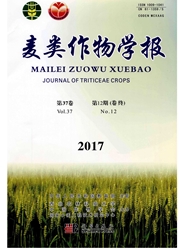

 中文摘要:
中文摘要:
为探索适宜的稻茬小麦栽培模式,基于本课题组近13年的田间试验数据,分析了播期、基本苗和肥料运筹对稻茬小麦产量及经济效益的影响,进而构建不同高产栽培模式,并比较其高产、稳产、节本增效的能力。结果表明,适播(10月29日-11月4日)条件下稻茬小麦产量、净效益和产投比均显著高于早播(10月17日-10月26日)和晚播(11月6日-11月20日),增幅分别为12%~13%、24%~27%和22%~27%,但不同播期之间的投入差异不显著。在适播条件下基本苗和施氮量、晚播条件下基本苗与产量和净收益均呈抛物线关系。适播基本苗210×10^4~240×10^4株·hm^-2和施氮量180~225kg·hm^-2、晚播基本苗240×10^4~270×10^4株·hm-2和施氮量240~270kg·hm^-2构建的高产模式下产量分别达8.21和7.46t·hm^-2,这两种模式均具有高经济效益和低投入特点,在不同年度、地点和品种下稳产性好。
 英文摘要:
英文摘要:
The main aim of this study is to provide a reference to wheat production for high yield,sta- ble production,low cost,and high efficiency in rice-wheat rotation system. The experimental data of 13 years on wheat production in rice-wheat rotation system was collected, to analyze the effects of so- wing date, seedling rates and fertilization application on grain yield and economic efficiency, and then to establish different high-yield cultivation modes. Furthermore, the capacities of high yield, stable pro- duction,low cost,and high efficiency were compared between/among these modes. The grain yield, economic income and input-output ratio under the condition of suitable sowing (October 29 to Novem- ber 4)was 12%-13%,24%-27% and 22%--27% higher than those under the condition of early so- wing (October 17 to October 26)and late sowing(November 6 to November 20). But there was no sig- nificant difference among different sowing dates. There was a parabola function relation between seed- ling rates and nitrogen rates under the condition of suitable sowing, and a parabola funvtion relation between seedling rates and grain yield and economic income under the condition of late sowing. Ac-cording to the analyses,the high-yield modes with seedling rates 210×10^4 --240×10^4plants · hm^-2 and nitrogen rates 180--225 kg · hm^-2 under the condition of suitable sowing,and with seedling rates 240×10^4-270×10^4 plants · hm^-2 and nitrogen rates 240--270 kg · hm^-2 under the condition of late sowing were respectively established,which gained the grain yield of 8.21 and 7.46 t · hm-2. Addi- tionally, compared to other modes, these modes showed higher economic income, lower input, and bet- ter stable production in different years, locations and varieties.
 同期刊论文项目
同期刊论文项目
 同项目期刊论文
同项目期刊论文
 期刊信息
期刊信息
